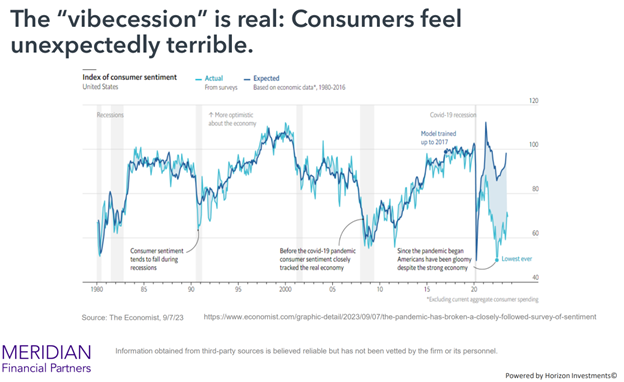When I realized it was my week to write the blog, I struggled with a topic because my heart is just sad. The news is scary and tragic, no matter what channel you are on. We’ve been talking to many of you, our clients, our friends, our peers, and there is just a lot of heaviness in the world—we’ve heard many happy stories worth celebrating, yet the sad ones are the ones that lodge in our hearts and minds and stay with us.
But I don’t mean to fill the page with gloom—it has just been hard to view the world with a positive lens—which has really permeated our calls and conversations with clients. It’s hard to view financial decisions objectively and without emotion, when you just feel…sad, anxious, nervous, angry…
And the weird part, is outside of how we feel, the economy keeps showing resilience with low unemployment, rising wages, above trend GDP growth, solid corporate earnings, etc. So, as all good financial pundits do, a new phrase has been coined…we are in a “vibecession”. Where the hard data looks solidly positive, but consumers and investors just feel really miserable. In an article by the New York Times, Martha Ross calls it a “cognitive dissonance” where we recognize how we feel and apparent reality are out of sync. That article states: “People are relying on their gut to determine the state of the economy because of the haunting feeling that any crumb of data used to explain the world may be irrelevant or canceled out by something else.”
So, when talking to our clients—and to ourselves—we have to keep remembering these three things:
- The stock market has always “climbed a wall of worry”…there is and always will be a reason to sell, but over time, the companies that make up the total stock market have been able to grow through all sorts of bad news:
- Bond math has changed–an opportunity in bonds exists that we have not seen since the financial crisis of 2008. Real bond yields are actually higher than inflation, and the chance of lower rates is greater than the chance of higher rates. So, bond investors can actually make a positive net real return from just the current interest rate on their bonds (generally around 5% currently), AND when rates begin to fall a little bit, bond prices will increase. This chart shows the price impact on different kids of bonds if interest rates FALL by 1% in dark blue—and the price impact if rates RISE by 1%–this is the kind of asymmetric risk that is attractive:
- There is much we cannot control—but there are a few things we have direct control over. So, we work hard to focus on those areas, even when the worry over the other ones is a powerful pull:
And, at the end of the day, when we stand up and go for a walk outside and enjoy the quiet and colors of fall, we know there is something right with the world today too.
The Yakel pets enjoying beautiful fall days…










